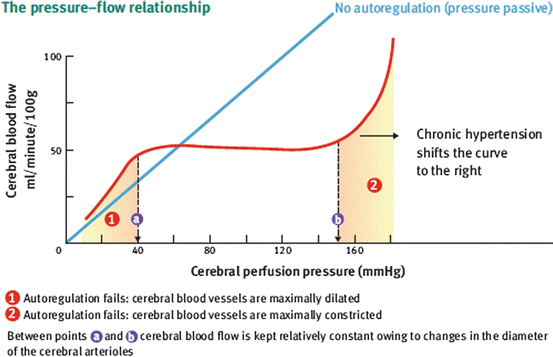Fig. 13.1
Escalating cycle of brain swelling resulting in energy failure, increase in brain damage and poor outcome following injury to the brain (With permission of Wolters Kluwer Health; Decompressive craniectomy in head injury. Curr Opin Crit Care 2004: 10(2):101–4)
Conversely, seizures and hyperthermia will increase CMRO2 and subsequently CBF and ICP. If not treated appropriately, both conditions are associated with poorer outcome after successful cardiopulmonary resuscitation. Antipyretics such as acetaminophen can be used to manage hyperthermia, as well as physical methods of cooling. Seizures can be controlled with antiepileptics like phenytoin, benzodiazepine and barbiturates.
Propofol
This is a commonly used drug in anesthesia and critical care, mainly as an induction agent and in total intravenous anesthetic technique in neuroanesthesia. It is also used as a sedative agent in critically ill patients especially in neurocritical care unit to provide cerebral protection. Propofol decreases the cerebral metabolic rate for oxygen (CMRO2), which leads to a reduction in CBF and ICP. However, one must be cautious when large doses are being used as it may result in systemic hypotension that will further compromise the CPP. Propofol is known to cause myoclonus but is non-epileptogenic, and is sometimes used to treat refractory status epilepticus.
Thiopental
Thiopental is less commonly used nowadays due to its unfavorable pharmacokinetic profile. It decreases CMRO2 and causes cerebral vasoconstriction which result in reduced CBF, cerebral blood volume (CBV) and ICP. Thiopental can cause significant hypotension, which can impair CPP. It is sometimes used in selected cases with refractory elevated ICP to produce a state of deep coma when other conventional therapies failed to reduce ICP. Induced coma with the use of barbiturates like thiopental is called barbiturate coma.
Benzodiazepines
Agents in this category such as midazolam are widely used as sedative agents in neurocritical care unit. Its effect on cerebral physiology is similar to the above drugs, but to a lesser degree, with a less significant drop in CMRO2, CBF, CBV and ICP.
Drugs Modulating Cerebral Blood Flow
Cerebral blood flow (CBF) is affected mainly by oxygen and carbon dioxide tensions in the blood and by autoregulation. CBF under normal conditions is maintained at a relatively constant rate despite variations in CPP. The mechanism involves alteration in the cerebral vascular resistance by changing the diameter of the cerebral arterioles. This phenomenon is known as autoregulation (Fig. 13.2). CBF is held constant over the CPP range of 50–150 mmHg. At the upper limit, the arterioles are maximally vasoconstricted and any increase in CPP will result in increased CBF. At the lower limit, the arterioles are maximally dilated in an attempt to maintain CBF, below which CBF becomes pressure dependent.


Fig. 13.2
Autoregulation of blood flow in the brain depending on cerebral perfusion pressure (With permission from Surgery (Oxford); Applied physiology of the CNS Surgery 2005; 23(1):7–12)
Cerebral perfusion pressure (CPP) depends on the mean arterial pressure (MAP) and the ICP or jugular venous pressure (JVP), whichever is greater, whereby
 Many conditions can affect this autoregulatory process, which includes traumatic brain injury, hemorrhage, infection, tumor and certain pharmacological agents. Cerebral blood flow can be controlled by manipulating the mean arterial pressure and by changing the caliber of the cerebral blood vessels.
Many conditions can affect this autoregulatory process, which includes traumatic brain injury, hemorrhage, infection, tumor and certain pharmacological agents. Cerebral blood flow can be controlled by manipulating the mean arterial pressure and by changing the caliber of the cerebral blood vessels.

Drugs Affecting Mean Arterial Pressure
From the equation above, agents that increase mean arterial pressure will also increase cerebral perfusion pressure, which may help to maintain cerebral blood flow. So, drugs which are used to support the cardiovascular system by increasing the mean arterial pressure (see Chap. 11) are often used to try to improve cerebral blood flow in conditions of raised ICP. In the adult brain, the CPP is normally between 70 and 90 mmHg.
Drugs Affecting Caliber of Cerebral Blood Vessels
Drugs which alter the radius of cerebral blood vessels are not commonly used to improve cerebral blood flow and oxygenation in cases of brain injury. The following drugs are used in the management of brain injury in specific situations.
Stay updated, free articles. Join our Telegram channel

Full access? Get Clinical Tree


